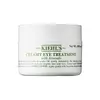What's inside
What's inside
 Key Ingredients
Key Ingredients

 Benefits
Benefits

 Concerns
Concerns

 Ingredients Side-by-side
Ingredients Side-by-side

Water
Skin ConditioningButyrospermum Parkii Butter
Skin ConditioningButylene Glycol
HumectantTridecyl Stearate
EmollientPEG-30 Dipolyhydroxystearate
EmulsifyingIsodecyl Salicylate
Skin ConditioningTridecyl Trimellitate
EmollientPersea Gratissima Oil
Skin ConditioningIsocetyl Stearoyl Stearate
EmollientPropylene Glycol
HumectantDipentaerythrityl Hexacaprylate/Hexacaprate
EmulsifyingSorbitan Sesquioleate
EmulsifyingMagnesium Sulfate
Hydrogenated Castor Oil
EmollientSodium PCA
HumectantPhenoxyethanol
PreservativeChlorphenesin
AntimicrobialHydrogenated Jojoba Oil
AbrasiveP-Anisic Acid
MaskingTocopheryl Acetate
AntioxidantIsopropyl Palmitate
EmollientDisodium EDTA
Copper PCA
HumectantHelianthus Annuus Seed Oil
EmollientCI 40800
Cosmetic ColorantCitric Acid
BufferingWater, Butyrospermum Parkii Butter, Butylene Glycol, Tridecyl Stearate, PEG-30 Dipolyhydroxystearate, Isodecyl Salicylate, Tridecyl Trimellitate, Persea Gratissima Oil, Isocetyl Stearoyl Stearate, Propylene Glycol, Dipentaerythrityl Hexacaprylate/Hexacaprate, Sorbitan Sesquioleate, Magnesium Sulfate, Hydrogenated Castor Oil, Sodium PCA, Phenoxyethanol, Chlorphenesin, Hydrogenated Jojoba Oil, P-Anisic Acid, Tocopheryl Acetate, Isopropyl Palmitate, Disodium EDTA, Copper PCA, Helianthus Annuus Seed Oil, CI 40800, Citric Acid
Water
Skin ConditioningGlycerin
HumectantCaprylic/Capric Triglyceride
MaskingAloe Barbadensis Leaf Juice
Skin ConditioningBetaine
HumectantPropylene Glycol
HumectantGlyceryl Stearate Se
EmulsifyingAphloia Theiformis Leaf Extract
AstringentPropanediol
SolventCaesalpinia Spinosa Gum
Skin ConditioningSorbitol
HumectantEthylhexylglycerin
Skin ConditioningGlyceryl Stearate Citrate
EmollientHydroxyacetophenone
AntioxidantMaris Aqua
HumectantInositol
HumectantBenzyl Alcohol
PerfumingSuccinoglycan
Skin ConditioningSodium Hyaluronate
HumectantCitric Acid
BufferingChenopodium Quinoa Seed Extract
Skin ConditioningHyaluronic Acid
HumectantHydrolyzed Algin
Tropaeolum Majus Flower/Leaf/Stem Extract
Skin ConditioningPhenethyl Alcohol
MaskingSucrose
HumectantTetraselmis Suecica Extract
Skin ConditioningSodium Benzoate
MaskingPotassium Sorbate
PreservativeTocopherol
Antioxidant1,2-Hexanediol
Skin ConditioningCaprylyl Glycol
EmollientHydrochloric Acid
BufferingCI 77163
Cosmetic ColorantWater, Glycerin, Caprylic/Capric Triglyceride, Aloe Barbadensis Leaf Juice, Betaine, Propylene Glycol, Glyceryl Stearate Se, Aphloia Theiformis Leaf Extract, Propanediol, Caesalpinia Spinosa Gum, Sorbitol, Ethylhexylglycerin, Glyceryl Stearate Citrate, Hydroxyacetophenone, Maris Aqua, Inositol, Benzyl Alcohol, Succinoglycan, Sodium Hyaluronate, Citric Acid, Chenopodium Quinoa Seed Extract, Hyaluronic Acid, Hydrolyzed Algin, Tropaeolum Majus Flower/Leaf/Stem Extract, Phenethyl Alcohol, Sucrose, Tetraselmis Suecica Extract, Sodium Benzoate, Potassium Sorbate, Tocopherol, 1,2-Hexanediol, Caprylyl Glycol, Hydrochloric Acid, CI 77163
 Reviews
Reviews

Ingredients Explained
These ingredients are found in both products.
Ingredients higher up in an ingredient list are typically present in a larger amount.
Citric Acid is an alpha hydroxy acid (AHA) naturally found in citrus fruits like oranges, lemons, and limes.
Like other AHAs, citric acid can exfoliate skin by breaking down the bonds that hold dead skin cells together. This helps reveal smoother and brighter skin underneath.
However, this exfoliating effect only happens at high concentrations (20%) which can be hard to find in cosmetic products.
Due to this, citric acid is usually included in small amounts as a pH adjuster. This helps keep products slightly more acidic and compatible with skin's natural pH.
In skincare formulas, citric acid can:
While it can provide some skin benefits, research shows lactic acid and glycolic acid are generally more effective and less irritating exfoliants.
Most citric acid used in skincare today is made by fermenting sugars (usually from molasses). This synthetic version is identical to the natural citrus form but easier to stabilize and use in formulations.
Read more about some other popular AHA's here:
Learn more about Citric AcidPropylene Glycol is an odorless, colorless liquid. As a humectant, it helps skin retain moisture. It also aids in delivering active ingredients.
Another role of this ingredient is preventing a product from melting or freezing. Propylene glycol also adds antimicrobrial properties to a product, elongating product lifespan.
This ingredient is considered an organic alcohol and commonly added into both cosmetics and foods.
Those with sensitive skin or conditions may develop a rash when using this ingredient.
Learn more about Propylene GlycolWater. It's the most common cosmetic ingredient of all. You'll usually see it at the top of ingredient lists, meaning that it makes up the largest part of the product.
So why is it so popular? Water most often acts as a solvent - this means that it helps dissolve other ingredients into the formulation.
You'll also recognize water as that liquid we all need to stay alive. If you see this, drink a glass of water. Stay hydrated!
Learn more about Water